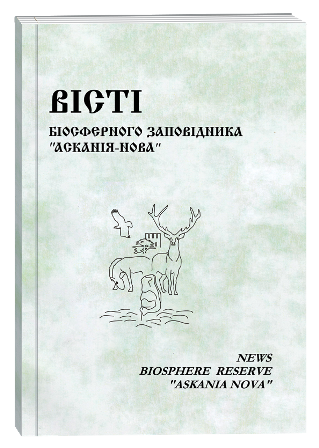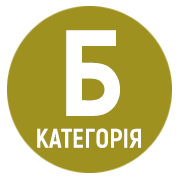THE CHARACTER OF BIOTOPES OF THE CHERNOBYL POPULATION OF THE PRZEWALSKI’S HORSE EQUUS FERUS PRZEWALSKII POLJAKOV, 1881
DOI:
https://doi.org/10.53904/1682-2374/2019-21/21Keywords:
Equus ferus przewalskii, біотопи, перелоги, продуктивність пасовищ, синтаксономія, ЧорнобильAbstract
Geobotanical studies of the biotopes of the Chernobyl population of Przewalski’s horses, which is the largest group of real wild horses in Europe, are presented. The analysis of their belonging to the syntaxa of the J. Braun-Blanquet classification scale, productivity and feeding value of the phytocenoses of the Chernobyl exclusion zone has been carried out. It has been defined that horses prefer of the psammophilic and steppe meadows group of vegetaion, Corynephorion canescentis, Koelerion glaucae and Agrostion vinealis, which have a low productivity. The Dauco-Melilotion and Convolvulo-Agropyrion repentis types of coenoses also play an important role in feeding of horses but have significantly higher productivity. Agropyro-Rumicion crispi communities on fallow lands are correspond with Fesucion pratensis grass communities of meadows that correspond to them in edaphic conditions. Now they play a lesser role in feeding of Przewalski’s horses, but they are very promising forage lands in case when population of animal will grow up. Przewalski's horses have an impact on the phytocoenosis and transform communities. Animals also contributes to the establishment of the natural phyto-limiting regime and increasing of biodiversity. Destroying of grassy turf, horses also contribute to the emergence of undergrowth of trees and the formation of woodlands. Currently, the feed base is not a limiting factor for increasing the population of Przewalski's horses. There are significant areas of free land, suitable for increase the population of Przewalski's horses. Strict protection (security) of the Chernobyl Biosphere Reserve can lead to an increase of the population up to 400-500 individuals - the minimum number for the long-term existence of their population.
References
Балашов Л. С., Негруца К. А. Придатність рослинного покриву Полісся для коней Пржевальського. Кінь Пржевальского (Equus przewalskii Pol., 1881): проблеми збереження та повернення в природу : мат-ли VI Міжнар. симпоз., присв. 100-річчю розведення виду в заповіднику "Асканія-Нова". Вестник зоологии. 1999. Спец. додаток № 11. С. 12–15.
Паскевич С. А., Петров М. Ф. Оценка накопления 90Sr 137Cs и структурными элементами растительных сообществ лугов и залежей Зоны отчуждения. Проблеми Чорнобиля. 2003. Вип. 13. С. 155–162.
Паскевич С. А., Петров М. Ф. Биогенные потоки радионуклидов в травянистых биоценозах Чернобыльской зоны отчуждения. Проблеми безпеки атомних електростанцій і Чорнобиля. 2004. Вип. 1. С. 154–160.
Петров М. Ф. Ботаніко-географічні дослідження Чорнобильської зони. Проблеми Чорнобильської зони відчуження. 2016. Вип. 15–16. С. 52–263.
Петров М. Ф. Динаміка рослинного покриву в зоні відчуження. Бюлетень екологічного стану зони відчуження та зони безумовного (обов'язкового) відселення. 2004. № 2 (24). С. 55–62.
Петров М. Ф. Зміни ґрунтово-рослинного покриву перелогів Чорнобильської зони відчуження. Фізична географія та геоморфологія. Київ : ВГЛ "Обрії", 2009. Вип. 55. С. 236–246.
Петров М. Ф., Кірєєв С. І. Природне заростання ложа водойми-охолоджувача ЧАЕС після пониження його рівня. Бюлетень екологічного стану зони відчуження та зони безумовного (обов'язкового) відселення. 2006. №1 (27). С. 78–82.
Петров М. Ф., Киреев С. И., Паскевич С. А. Запасы наземного органического вещества экосистем лугов и залежей зоны отчуждения ЧАЭС как горючего материала. Проблемы радиоэкологии леса. Лес. Человек. Чернобыль : сб. науч. тр. ИЛ НАН Беларуси. Гомель : ИЛ НАН Беларуси. 2004. Вып. 61. С. 117–120.
Программа и методика биогеоценологических исследований / под ред. Н.В. Дылиса. Москва : Наука, 1974. 402 с.
Родин Л. Е., Ремезов Н. П., Базилевич Н. И. Методические указания к изучению динамики и биологического круговорота в фитоценозах. Ленинград : Наука, 1968. 143 с.
Слівінська К. А., Балашов Л. С. Фітоценотичний склад кормових угідь коня Пржевальського (Equus przewalskii Poljakov, 1881) в умовах Чорнобильської зони відчуження. Укр. ботан. журн. 2006. Вип. 63, № 1. С. 22–30.
Соломаха В. А. Синтаксономія рослинності України. Третє наближення. Київ : Фітосоціоцентр, 2008. 296 с.
Стратегия сохранения зубра в России. Москва : Всемирный фонд дикой природы (WWF), 2002. 45 с.
Червона книга України. Тваринний світ / за ред. І.А. Акімова. Київ : Глобалконсалтинг, 2009. 600 с.
Mosyakin S. L., Fedoronchuk M. M. Vascular plants of Ukraine. A nomenclatur cheklist. Kiev, 1999. 760 р.
Mucina L., Bültmann H., Dierßen K. et al. Vegetation of Europe: hierarchical floristic classification system of vascular plant, bryophyte, lichen and algal communities. Applied Vegetation Science. 2016. Vol. 19 (Suppl. 1). S. 3–264.







